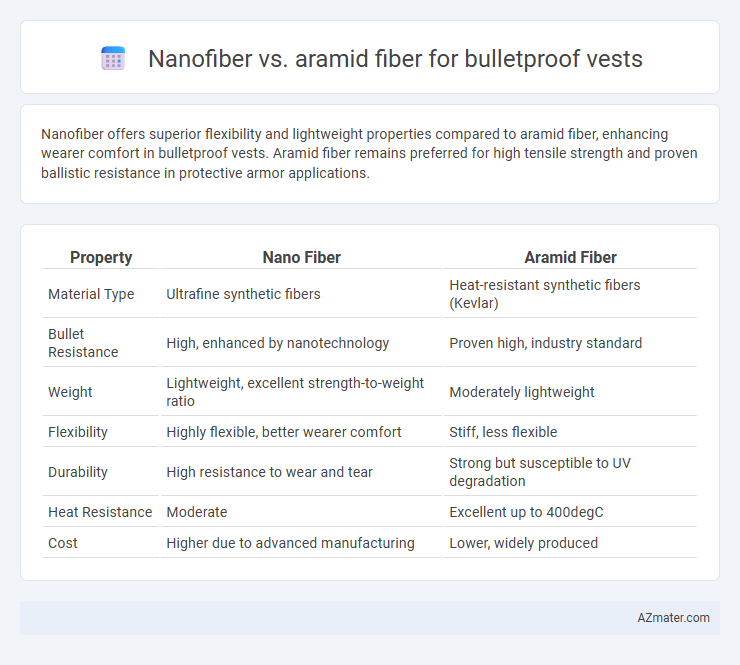Nanofiber offers superior flexibility and lightweight properties compared to aramid fiber, enhancing wearer comfort in bulletproof vests. Aramid fiber remains preferred for high tensile strength and proven ballistic resistance in protective armor applications.
Table of Comparison
| Property | Nano Fiber | Aramid Fiber |
|---|---|---|
| Material Type | Ultrafine synthetic fibers | Heat-resistant synthetic fibers (Kevlar) |
| Bullet Resistance | High, enhanced by nanotechnology | Proven high, industry standard |
| Weight | Lightweight, excellent strength-to-weight ratio | Moderately lightweight |
| Flexibility | Highly flexible, better wearer comfort | Stiff, less flexible |
| Durability | High resistance to wear and tear | Strong but susceptible to UV degradation |
| Heat Resistance | Moderate | Excellent up to 400degC |
| Cost | Higher due to advanced manufacturing | Lower, widely produced |
Introduction to Bulletproof Vest Materials
Bulletproof vests utilize advanced materials such as nanofibers and aramid fibers to enhance ballistic protection and durability. Aramid fibers, including Kevlar and Twaron, are renowned for their high tensile strength, heat resistance, and proven effectiveness in stopping bullets. Nanofibers offer a cutting-edge alternative with superior surface area and lightweight properties, contributing to improved flexibility and potentially increased ballistic performance in protective gear.
What are Nano Fibers?
Nano fibers are ultra-fine fibers with diameters measured in nanometers, typically less than 100 nanometers, offering exceptional strength-to-weight ratios and flexibility. Compared to aramid fibers, which are traditional synthetic fibers known for high tensile strength and heat resistance, nano fibers exhibit greater surface area and enhanced mechanical properties, making them promising for bulletproof vest applications. These fibers improve ballistic performance by providing superior energy absorption and penetration resistance at a significantly reduced thickness and weight.
What are Aramid Fibers?
Aramid fibers are synthetic fibers known for their exceptional strength, heat resistance, and durability, making them a popular choice in bulletproof vests and other ballistic protection gear. These fibers, such as Kevlar and Twaron, have high tensile strength-to-weight ratios, providing lightweight yet effective protection against ballistic impacts. Compared to nanofibers, aramid fibers offer proven performance in stopping bullets while maintaining flexibility and comfort for the wearer.
Mechanical Strength Comparison
Nano fibers exhibit superior tensile strength and flexibility compared to aramid fibers, enabling enhanced energy absorption and impact resistance in bulletproof vests. While aramid fibers such as Kevlar offer high durability and proven ballistic protection, nano fibers like carbon nanotubes provide greater mechanical strength-to-weight ratios, improving overall vest performance without adding bulk. The integration of nano fibers can significantly increase the vest's ability to withstand higher velocity projectiles due to their exceptional stiffness and toughness at the nanoscale.
Weight and Comfort Factors
Nanofiber materials featured in bulletproof vests offer significantly reduced weight compared to traditional aramid fibers, enhancing overall wearability without compromising ballistic protection. The ultra-fine structure of nanofibers improves flexibility and breathability, resulting in greater comfort during extended use by minimizing heat retention and restricting moisture buildup. Conversely, aramid fibers, while highly durable and resistant to heat, tend to be bulkier and heavier, which can limit mobility and increase fatigue for the wearer.
Ballistic Protection Performance
Nano fibers exhibit superior ballistic protection performance compared to aramid fibers due to their higher tensile strength and energy absorption capabilities. The nanoscale structure enhances fiber alignment and density, resulting in improved resistance to high-velocity projectiles and reduced backface deformation. Aramid fibers remain widely used for their proven durability and thermal stability, but nano fiber composites offer increased flexibility and lighter weight without compromising protection levels.
Durability and Longevity
Nano fibers in bulletproof vests offer exceptional durability due to their high tensile strength and resistance to wear at the molecular level, resulting in extended longevity under repeated stress conditions. Aramid fibers, such as Kevlar, provide proven durability with excellent energy absorption but tend to degrade faster when exposed to UV light and moisture. The advanced durability of nano fibers often translates to longer service life and enhanced protective performance compared to traditional aramid fibers in ballistic applications.
Flexibility and Design Adaptability
Nanofibers exhibit superior flexibility compared to aramid fibers, allowing bulletproof vests to conform more comfortably to body movements without compromising protection. The nanoscale diameter of these fibers enables intricate weaving patterns and thinner layers, enhancing design adaptability for varied ergonomic requirements. Aramid fibers, while strong and heat-resistant, tend to be stiffer, limiting customization in lightweight, flexible vest designs.
Cost Analysis and Availability
Nano fibers offer advanced ballistic protection with lightweight properties but remain costly due to complex manufacturing processes, limiting widespread availability in bulletproof vest production. Aramid fibers like Kevlar present a more cost-effective solution, balancing performance and affordability with established supply chains and mass production capabilities. The economic advantage and accessibility of aramid fibers make them the preferred choice for large-scale bulletproof vest manufacturing despite the superior technical properties of nano fibers.
Future Trends in Bulletproof Vest Technology
Nano fiber materials exhibit exceptional tensile strength and flexibility, outperforming traditional aramid fibers in lightweight bulletproof vest applications. Emerging technologies integrate nano fibers with advanced composites to enhance multi-hit resistance and ballistic performance while reducing vest weight. Continued research aims to optimize nano fiber production scalability and incorporate smart textile capabilities for real-time damage detection and adaptive protection.

Infographic: Nano fiber vs Aramid fiber for Bulletproof vest
 azmater.com
azmater.com